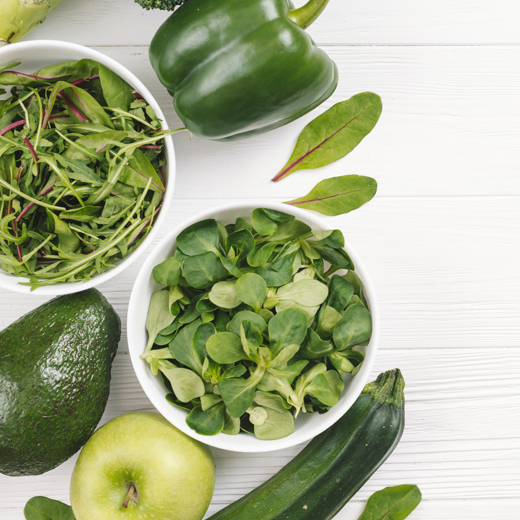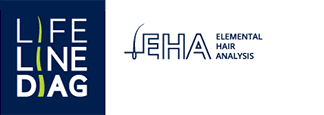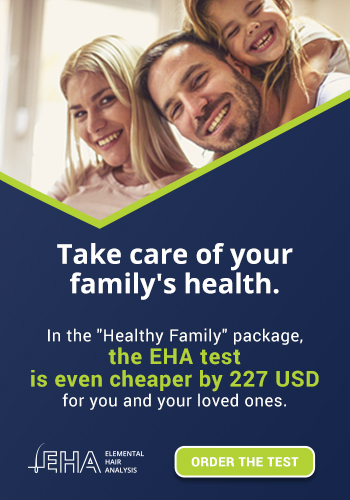
It’s widely believed that vegans and vegetarians are very susceptible to iron deficiency because as we know, the reason for insufficient iron is not enough being supplied in food to meet the body’s needs. Unfortunately, often, a seemingly healthy but actually poorly designed plant-based diet not only doesn’t have enough iron but also hinders iron absorption due to the presence of fibre, phytates, oxalates and polyphenols. So how can we balance the vegetarian and vegan menus to not risk anaemia and other dangerous effects of iron deficiency, and is this even possible?
Iron is one of the basic microelements required for the proper functioning of the body; its main role is transporting oxygen from the lungs to tissues. Hence, a deficiency causes a decline in the physical condition, dizziness, memory problems, difficulty breathing and heart problems. Vegans and vegetarians should be particularly careful because their diet lacks heme iron, which is the form that’s best absorbed. Grain products, vegetables and fruit also contain iron, but in non-heme form, which is absorbed at 1-5%. Heme iron in meat (particularly red meat) and fish is absorbed at 10-25%.
Iron deficiency doesn’t affect only vegans and vegetarians. While they are more at risk, this deficiency also affects people whose diets include meat. A meat-based diet often includes processed food, carbohydrates and fats, and doesn’t meet nutritional requirements to the extent that a healthy plant-based diet does. Women also have a problem with providing the right amount of iron (mainly due to iron loss during menstruation); their recommended intake of this element is almost double that of men – the RDA for men is 10 mg/dl, while for women it’s 18 mg/dl, and during pregnancy and breastfeeding it goes up to 27 mg/dl. Children during puberty also have an increased need for iron, as do the elderly, people with digestive disorders or malabsorption, blood donors and athletes (particularly runners). When designing a vegan or vegetarian diet, you must take into account the fact that the official norms for iron consumption were established for 15-18% absorption, and only iron from meat products is absorbed at this level.
Renate Huch and Roland Schaefer, authors of the book “Iron deficiency and iron deficiency anaemia” list vegetarians as one of the main groups at risk of a deficiency in this element. A risk factor is, obviously, an incorrectly implemented vegetarian or vegan diet due to a lack of knowledge and preparation, as well as it being used by the above-mentioned risk groups, i.e. the elderly, young children, athletes, and women who are pregnant, breastfeeding, or experience heavy periods.
Symptoms of iron deficiency:
- weakness and apathy
- getting fatigued quickly
- pale skin and lips
- nose bleeds
- mouth and tongue ulcers
- heart problems (palpitations)
- memory difficulties
- decreased concentration
- bruising easily
- muscle weakness
- hair loss and nail brittleness
- decreased immunity
- in children: poor mental development and low height
Long-term untreated iron deficiency may lead to anaemia, as well as disrupted growth, mental and motor development in children and adolescents, and decreased immunity. In pregnant women, there is a risk of premature labour or miscarriage, and iron deficiency can often lead to placental insufficiency, puerperal fever, low birth weight of the child, and even a risk to the child’s life. A decision to start a plant-based, vegan or vegetarian diet should always be consulted
with a dietician.
ARE VEGETARIANS AND VEGANS DOOMED TO IRON DEFICIENCY?
Until recently, there were questions as to whether plant products containing non-heme iron can be the only source of this element, and whether the body is able to use them properly. However, these doubts were dispelled thanks to the results of research carried out in various regions of the world. It also turned out that non-heme iron is safer for the body than heme iron from animal products. Another argument that supports plant-based iron is the fact that iron in food can be absorbed by the body in the presence of vitamin C, copper and cobalt. Animal products such as liver, which was considered to be the richest source of iron, doesn’t contain any vitamin C, while greens do have vitamin C, as well as copper and cobalt in the right proportion. Anaemia affects people who have a poorly varied diet, eating mainly refined products; these people also often implement weight-loss programmes incorrectly and take medications.
Anaemia doesn’t affect vegans and vegetarians more than other people – it usually affects those who have a poorly varied diet, eating mainly refined products; these people also often implement weight-loss programmes incorrectly and take medications.
In the light of research and observations by doctors of the Association for Responsible Medicine, previously popular arguments, such as that only meat is a source of absorbable heme iron and vitamin B12, are losing credibility. Research carried out recently in China has shown that the level of iron consumption in Chinese people who have a plant-based diet is higher than that found in the US. How’s this possible? Products that are known as good sources of iron include liver and other offal, spinach and molasses. However, whole grains, beans, green leafy vegetables and seeds usually contain comparable amounts of iron, while algae contain two to four times more than animal products do.
Amaranth contains many bioelements, such as iron, calcium, magnesium, phosphorus and potassium. It doesn’t have any gluten, and instead contains high amounts of vitamins, particularly A and E, which is the vitamin of “eternal youth”, as well as B and C. In terms of iron content, it has five times more than spinach does.
Nuts are an invaluable source of dietary iron (they’re also rich in calcium and other elements needed for blood production and bone building), as are fruits, vegetables and whole grains with the bran. However, it’s not just about the presence of only iron in a product, but also other substances that facilitate or hinder the body’s absorption of it. There’s lots of iron in various varieties of beans and peas, seeds, as well as broccoli, cos lettuce and other varieties thereof.
Whole grains, beans, green leafy vegetables and seeds usually contain amounts of iron that are comparable to animal products, and algae have two to four times more iron.
However, some plants that are rich in iron contain substances that hinder the absorption of mineral salts, including iron. These include oxalic acid found in spinach, sorrel, rhubarb, beet leaves and chard, which should be replaced with kale, cabbage, dandelion, mustard and turnips.
The absorption of mineral salts is also impeded by saponins, which are found in soybeans, spinach and beetroot, as well as by phytic acid, which is found in cereal grains, nuts and beans, which, however, are still a good source of iron due to the presence of phytase in the human intestine; it’s an enzyme that digests part of phytic acid so that iron and other mineral salts can be absorbed.
Indeed, vegans may have difficulty getting iron if the diet is chronically poor. Sweets and white bread, strong tea, and even excessive fibre in bran (oats should be rinsed before eating), beans and oats can deplete the body’s reserves of this element. However, the most common causes of iron deficiency include blood loss, a diet poor in minerals, the consumption of milk products in some children (milk products contain very little iron, and can stimulate hidden intestinal blood secretion and outflow from the body).
Doctor Roman Pawlak, professor of nutrition at East Carolina University in the United States, author of a series of scientific studies published in the US and international journals, and co-author of the book “Vegetarian mother and her child”, writes: “In the vegetarian diet, iron is absorbed well from plant-based products thanks to the presence of vitamin C. A vegetarian diet contains more vitamin C than a mixed diet because of the higher consumption of raw fruit and vegetables. (…) The absorption of iron from food is improved by vitamin C consumed in the same meal, for example, in oranges, pepper or parsley, an adequate level of hydrochloric acid in the stomach, and the action of hormones present in the body during pregnancy. Iron absorption is immediately hindered by drinking coffee, highly sweetened soft drinks and tea (due to the presence of tannic acid). Drinking tea during a meal or an hour before or after can decrease iron absorption even up to 87%. Iron absorption is also hampered by excess phosphorus and calcium in the diet, and by some antacids containing calcium and phosphorus salts.”
Drinking tea during a meal or an hour before or after can decrease iron absorption even up to 87%
Dr med. Ludwig M. Jacob has a similar opinion of the vegan and vegetarian diet and tells about research results in his writing (Theil et al., 2012, Lonnerdal, 2007). These results show that iron requirements can also be met by implementing a plant-based diet. This research demonstrated that contrary to previous theories, in addition to iron ions, iron chloride and iron chylate, the body can also use ferritin (which stores iron) thanks to a different mechanism.
As Dr Jacob writes, “Ferritin is a protein complex used to store protein in the organisms of animals and plants. The iron that is bound to this complex is harmless to the body and non-reactive. One human ferritin complex can bind up to 4,000 iron atoms. The greatest benefit of taking ferritin is that it’s the least harmful form of iron, and the only form present in the blood in higher amounts.”
Dr Jacob also states that “One should avoid preventive, groundless taking of iron supplements. Excess iron contributes to the onset of atherosclerosis and cancer. Iron deficiency is best prevented by a varied diet based on iron-rich plant products, such as parsley, pumpkin sprouts, millet, soy, amaranth, chanterelles, sunflower seeds, legumes (white beans, peas), apricots, whole grain bread, oats, algae, chlorella, spirulina, and beetroot. These products often contain the same amount or even more iron than meat: sesame 10 mg/100 g, amaranth 9 mg/100 g, and whole wheat flour (type 1700) 5 mg/100 g, while pork contains 1.5-2 mg/100 g.” Dr Jacob also notes that sometimes, deficiencies in different elements, such as B12 or iron, aren’t the result of insufficient amounts in the diet, but the presence of parasites in the body.
It’s also worth citing Julie Gellatley, author of the book “VIVA! Vegetarianism”, who writes “Iron is found in meat, but also in many types of vegetarian foods, such as legumes, wholemeal bread (from whole grain flour), green leafy vegetables, dried fruit (especially apricots and figs) and cacao (a good excuse to have some chocolate). Iron is also found in pasta, pumpkin seeds, sesame, pistachio nuts, cashew nuts, fortified breakfast cereals and jacket potatoes.”
As is clear from the above, not every vegan and vegetarian is doomed to anaemia. A well balanced diet can provide a sufficient amount of iron. However, you should remember it’s not just about which products to include in a meat-free menu, but about how the diet is designed.
The basic rule is to include vegetables and fruit rich in vitamin C with every meal containing iron, which increases absorption up to five times.
Don’t forget!
- The bioavailability of plant-derived iron is increased up to five times by the simultaneous intake of Vitamin C.
- Iron deficiency is often related to an insufficient amount of A-group vitamins, vitamin B6, B12 and folic acid, as well as copper, cobalt and iodine.
- Oxalates, saponins, phytates, tannins, polyphenols, fibre, calcium, zinc, manganese and phosphorus hinder iron absorption.
- The need for iron is increased by physical exertion, regular blood donation, and for women, menstruation and breastfeeding.
THE FIRST STEP – DIAGNOSTICS
It should be highlighted that before implementing any dietary or supplementation changes, you should first carry out the right diagnostic tests. Tests that determine your iron levels include peripheral blood count with the level of platelets and smear and diagnostics of the number of reticulocytes. You can also carry out supplementary testing of the concentration of stored iron (ferritin), of iron transport function (transferrin saturation), and a test that shows the level of utilisation of iron in the bone marrow.
The level of iron in the body can also be determined using an EHA test – elemental hair analysis. This test lets you see the body’s trends and tendencies, and thus prevent many diseases by detecting their precursors (in the form of a mineral imbalance) at a very early stage of their development. An EHA is an analysis at the cellular level that enables us to find even subtle disorders. EHA also shows the mineral status of the body not only on the day of the test but over a period of approximately three months. This means that it allows us to see actual nutritional deficiencies, which is helpful in diagnosing health problems and is an excellent prophylactic measure that assesses the functioning of the body, as well as the correctness of the diet and lifestyle. In a healthy adult, the average iron content in the body should be 3-4 g. For your body to be able to absorb 1-2 mg of iron daily, which is the amount needed to maintain adequate levels, your daily diet should contain 5-10 mg of iron. An EHA test verifies whether or not this supply is met.
In summary, vegans and vegetarians with a poorly varied plant-based diet who eat mainly processed foods and many sweets, implement weight-loss programmes poorly and take medication often, as well as that drinking a large amount of coffee, black tea and sweet soft drinks can have an iron deficiency. This is similar with people who have a traditional, monothematic diet based on fast food, and people with various diseases (parasites, chronic enteritis, coeliac disease, gastric and duodenal ulceration, or helicobacter pylori infection). On the other hand, if a vegetarian or vegan diet is well balanced, i.e. it’s based on organic, seasonal and varied products and doesn’t contain stimulants, it can fully meet the body’s needs for iron and other nutrients.
Agnieszka Biernat, Dieta wegańska a niedobór żelaza [The vegan diet and iron deficiency – must one always accompany the other?], DietPoint, 1(4)/2020, S. 4-9.










